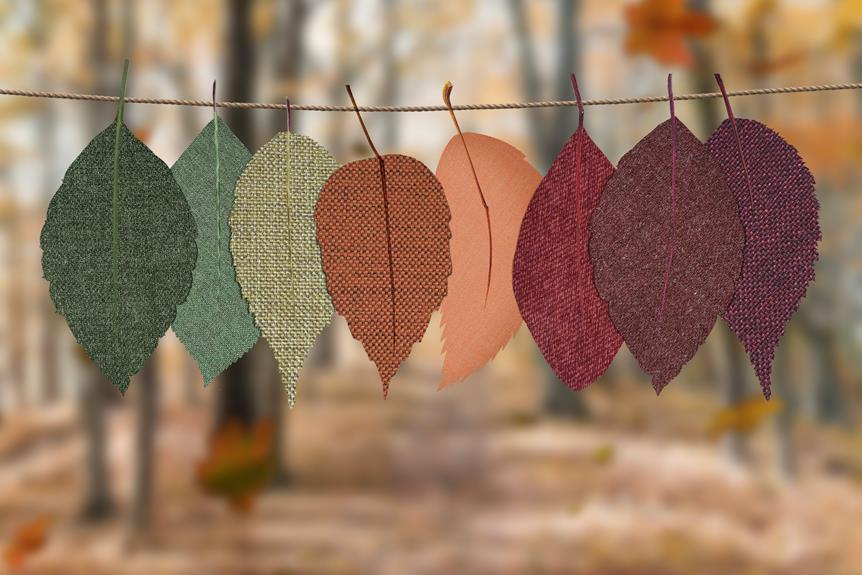Hey there, curious about which fabrics E6000 adhesives can work its magic on? Look no further!
E6000 adhesives are like a superhero for fabrics, bonding with ease to cotton, denim, leather, felt, polyester, and silk.
Whether you're crafting, repairing, or creating something entirely new, E6000 has got you covered.
Stick around to discover the amazing possibilities this adhesive opens up for your fabric projects.
Key Takeaways
- E6000 adhesives can bond cotton, denim, leather, felt, polyester, and silk fabrics.
- Clean fabric surfaces are important for optimal adhesion strength, especially for silk fabric.
- Proper application of E6000 adhesive, including thin and even distribution, enhances adhesion strength on silk fabric.
- The type of material being bonded, such as cotton, metal, or plastic, should be considered for improved adhesion.
Cotton
When using E6000 adhesives, you can successfully bond cotton fabric to various surfaces.
Cotton bonding techniques with E6000 involve ensuring that the fabric is clean and free of any residues that may hinder adhesion.
The key to achieving optimal cotton adhesion strength is to apply the adhesive evenly to the fabric and the chosen surface, ensuring full coverage.
Press the fabric firmly onto the surface and allow it to set for the recommended time as per the adhesive's instructions. This process enhances the bonding strength and ensures a durable hold.
Additionally, when working with cotton, it's important to consider the porosity of the fabric.
If the cotton fabric is particularly porous, applying a thin initial coat of adhesive and allowing it to dry before adding a second coat can significantly improve adhesion.
Denim
Denim is a popular fabric for many types of clothing. It's important to know how well E6000 adhesives can bond with it. You might be wondering about the strength of the bond and the durability of the adhesion when it comes to denim. Let's explore the specific points related to denim bonding strength and E6000 adhesion durability.
Denim Bonding Strength
To test the bonding strength of E6000 adhesive on denim, you can conduct a simple adhesion test.
When you witness the E6000 adhesive forming a strong bond with the denim, it can evoke a sense of confidence in its reliability for your denim projects. This can lead to a feeling of assurance that your denim creations will endure various conditions without compromising the bond. Ultimately, the successful adhesion of E6000 adhesive to denim can instill a sense of satisfaction, knowing that your fabric will stay securely in place.
Understanding denim adhesion properties and employing effective denim bonding techniques can lead to a profound sense of accomplishment in your crafting endeavors.
E6000 Adhesion Durability
You may notice an increase in confidence when the E6000 adhesive forms a strong bond with your denim, indicating its reliability for your projects. The fabric compatibility of E6000 adhesives makes them well-suited for bonding with denim, offering a durable adhesion that withstands the rigors of daily wear.
When applied correctly, E6000 forms a long-lasting bond with denim, ensuring that your projects maintain their quality over time. This adhesion longevity is crucial for denim-related applications, such as repairing jeans, creating denim crafts, or adding embellishments to denim garments.
With E6000 adhesives, you can trust that your denim projects will maintain their integrity, even with frequent use and laundering. The reliable bond between E6000 adhesives and denim makes them a go-to choice for various crafting and repair needs.
Leather
When working with leather, it's important to consider the type of E6000 adhesive that will best suit your project. The right adhesive can make all the difference in leather adhesion techniques and bonding strength.
Here are some key points to keep in mind:
- Versatility: E6000 adhesives are versatile and can bond with various types of leather, including genuine, synthetic, and suede. This versatility allows you to work with different leather materials for a wide range of projects, from crafting to repair work.
- Reliability: The bonding strength of E6000 adhesives ensures a reliable and durable hold, providing confidence in the longevity of your leather projects. Whether you're creating leather accessories or repairing a beloved item, you can trust that the bond will withstand regular use and wear.
- Professional Finish: Using E6000 adhesives for leather projects results in a professional-looking finish. The adhesive creates a seamless bond, enhancing the overall aesthetic appeal of your craftsmanship.
Understanding these aspects of E6000 adhesives can empower you to take on leather projects with confidence, knowing that you have a reliable adhesive at your disposal.
Felt
So, you're wondering about bonding felt with E6000 adhesives?
Let's talk about some effective techniques for bonding felt and the specific applications of E6000 adhesive when working with this fabric.
It's important to understand how to properly use E6000 adhesive to ensure a strong and durable bond with felt.
Felt Bonding Techniques
Felt bonding with E6000 adhesives requires patience and precision to achieve effective adhesion. When working with felt, consider needle felting to create intricate designs that seamlessly blend with the fabric.
Additionally, explore fabric manipulation techniques such as pleating, gathering, or ruching to add depth and texture to your felt projects.
As you master these techniques, you'll experience a sense of satisfaction as your creations come to life, reflecting your dedication and attention to detail. The process may be challenging at times, but the satisfaction of achieving a strong bond and creating stunning felt pieces will make it all worthwhile.
Keep refining your skills, and soon you'll be adept at using E6000 adhesives for felt bonding, bringing your artistic visions to fruition.
E6000 Adhesive Applications
To bond felt using E6000 adhesives, follow the recommended application guidelines for optimal results.
Start by ensuring that the felt is clean and free from any dirt or debris.
Apply a thin, even layer of E6000 adhesive to the felt surface that you want to bond.
Press the surfaces firmly together and hold them in place for a few minutes to allow the adhesive to set.
For larger or heavier felt pieces, you may need to use clamps or weights to keep the bond secure while the adhesive cures.
Once the adhesive has set, allow the bonded felt to cure for at least 24 to 72 hours before subjecting it to any stress or strain.
Following these fabric bonding techniques will help you achieve strong and durable bonds when using E6000 adhesives.
Polyester
You can easily bond polyester fabric using E6000 adhesives. When working with polyester, it's important to follow these bonding tips and adhesion techniques:
- Versatility: E6000 adhesives offer exceptional versatility, allowing you to bond polyester fabric to a wide range of materials. This versatility gives you the freedom to explore various creative projects without limitations.
- Durability: The strong bond created by E6000 adhesives ensures the durability of the polyester fabric, providing a reliable and long-lasting hold. This durability gives you the confidence that your bonded polyester fabric will withstand everyday wear and tear.
- Professional Finish: E6000 adhesives deliver a professional finish when bonding polyester fabric, enhancing the overall aesthetic appeal of your projects. Achieving a polished and professional look can be incredibly satisfying and elevate the quality of your work.
Silk
When bonding silk fabric with E6000 adhesives, consider its delicate nature and the need for precise application to ensure a strong and lasting hold.
Silk is a luxurious and delicate fabric that requires special care when using adhesives. To achieve optimal silk adhesion strength, it's essential to follow specific silk bonding techniques.
Firstly, ensure that the silk fabric is clean and free from any dirt or residue that could interfere with the adhesive bond. Additionally, it's crucial to apply the E6000 adhesive thinly and evenly onto the silk fabric to avoid any clumping or uneven adhesion.
When bonding silk to other materials, such as metal or plastic, be mindful of the weight and stress that the bond will need to withstand.
Frequently Asked Questions
Can E6000 Adhesives Bond to Stretchy Fabrics Like Spandex or Lycra?
Yes, E6000 adhesives can bond to stretchy fabrics like spandex or lycra. However, it's important to apply it thinly and let it dry for at least 24 hours for maximum adhesion strength and durability.
Will E6000 Adhesives Work on Synthetic Fabrics Like Nylon or Rayon?
Yes, E6000 adhesives will work on synthetic fabrics like nylon or rayon. Their adhesive compatibility with synthetic fabrics makes them effective for fabric adhesion. They provide a strong and durable bond.
Can E6000 Adhesives Bond to Delicate Fabrics Like Chiffon or Organza?
E6000 adhesives can bond to delicate fabrics like chiffon or organza. The adhesive strength is reliable, and the fabric compatibility is excellent. It's important to follow the application instructions for the best results.
Will E6000 Adhesives Work on Heavily Textured Fabrics Like Corduroy or Velvet?
E6000 adhesives will bond well to heavily textured fabrics like corduroy or velvet. They also provide strong adhesion on stretchy materials, making them a versatile choice for various fabric types.
Can E6000 Adhesives Bond to Waterproof or Water-Resistant Fabrics Like Gore-Tex or Neoprene?
E6000 adhesives can bond to waterproof or water-resistant fabrics like gore-tex or neoprene. They're also great for bonding leather and denim, as well as adhering silk and satin. The versatility of E6000 is impressive!
- How Thick Is Kevlar Fabric? Thickness Vs Protection Level - June 21, 2025
- Honeywell Kevlar Fabric: Trusted Name in Aramid Fibers - June 21, 2025
- Hexcel Kevlar Fabric: Aerospace-Grade Material Overview - June 21, 2025







